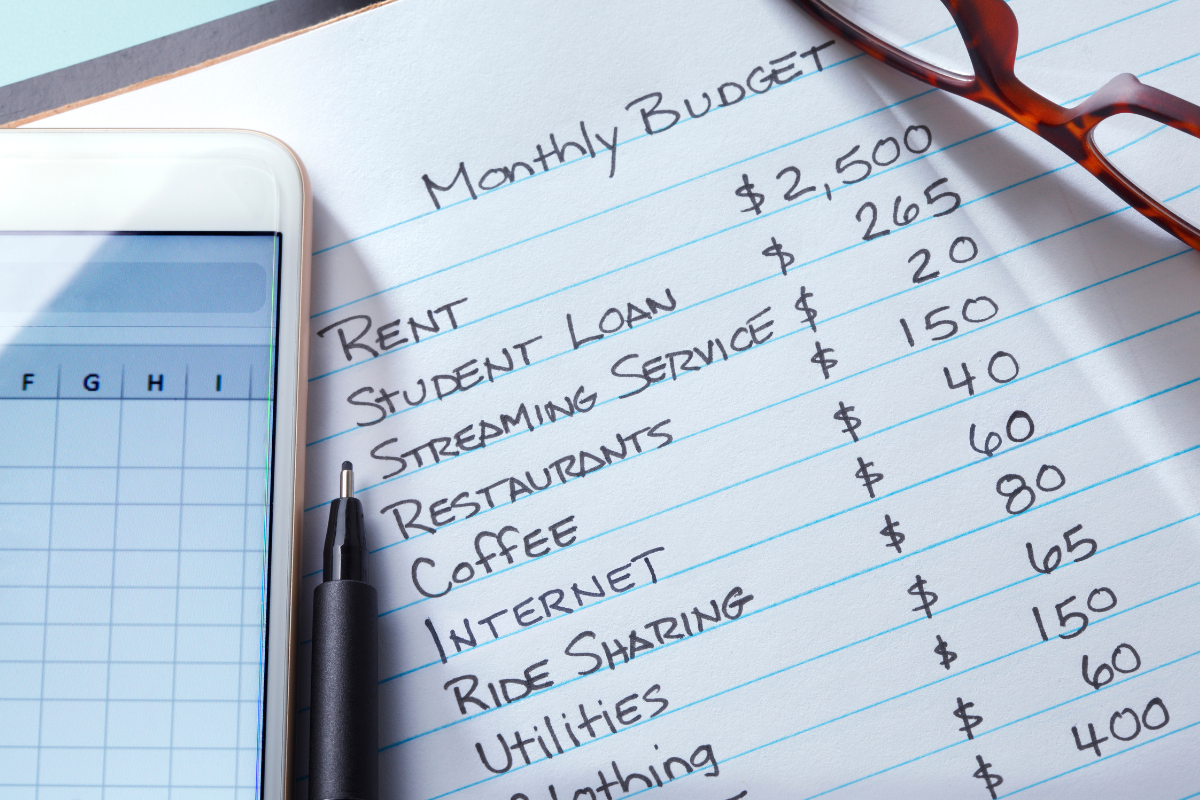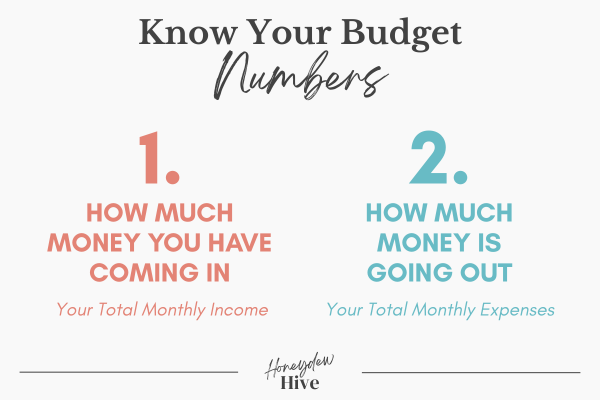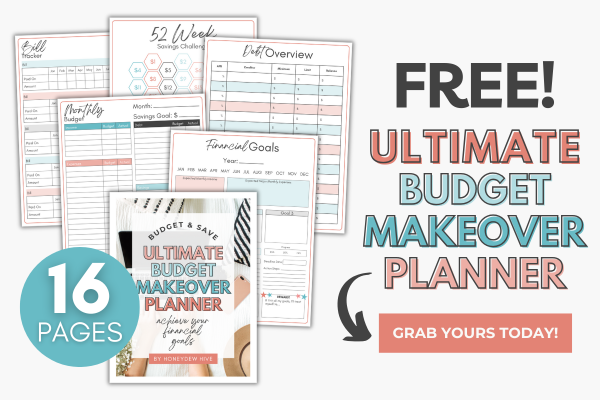Budgeting 101: A Beginner’s Guide to Creating a Monthly Budget

Let’s be honest—budgeting can feel overwhelming when you’re just getting started.
Maybe you’ve tried to create a budget before, but gave up after a few weeks. Maybe you’ve avoided it altogether because it seemed too complicated, too restrictive, or just too stressful.
You’re not alone.
The truth is, budgeting isn’t about limiting your freedom—it’s about giving your money a purpose.
When you have a clear plan for where your money is going, you gain control, reduce stress, and start making real progress toward your goals.
This beginner’s guide is designed to make budgeting feel simple, doable, and even empowering.
I’ll walk you through exactly how to create a monthly budget in five easy steps, plus share tips to help you stick with it and avoid common mistakes.
And if you want a little extra help getting started, grab my free Ultimate Budget Makeover Planner—it’s packed with templates and trackers to help you set up your budget and make it work for your real life.
What Is a Budget—and Why You Need One
A budget is simply a plan for how you’ll use your money each month. It tells your dollars where to go—before they disappear.
At its core, budgeting is about being intentional with your income so you can cover your needs, enjoy your wants, and still make progress on your bigger financial goals.

Many people hear the word “budget” and immediately think: restrictive, stressful, boring. But the truth is, a good budget isn’t about saying no to everything—it’s about giving yourself permission to spend with confidence because you’ve already made a plan.
Why You Need a Budget
Even if your income is steady, it’s easy to feel like you’re just treading water financially. That’s where a budget comes in. When you create a monthly plan for your money, you:
- Stop living paycheck to paycheck
- Know exactly where your money is going
- Make faster progress on savings or debt payoff
- Feel more in control (and less stressed) about your finances
- Reduce impulse spending and guilt-based purchases
A budget gives you clarity. It helps you prioritize what matters most and avoid the feeling of, “Where did all my money go?”
No matter what your income looks like right now, a budget is the foundation that helps you build a more stable, less stressful financial future.
And the good news? You don’t have to get it perfect—you just have to get started.
How to Create a Monthly Budget in 5 Simple Steps
You don’t need fancy spreadsheets, complicated formulas, or hours of free time to build a budget that actually works. All you need is a plan—and a willingness to be honest with yourself about where your money is going.
These five steps will help you create a realistic monthly budget that fits your life, not someone else’s.
Step 1: Know Your Numbers
Start by getting clear on the two most important pieces of information:
- How much money you have coming in (your total monthly income)
- How much money is going out (your monthly expenses)
List every source of income you receive in a typical month—whether it’s a paycheck, side hustle income, child support, or anything else.
Then, track your spending for at least one full month. Go through your bank and credit card statements to see where your money has actually been going—not just where you think it goes.

Pro Tip: My free Ultimate Budget Makeover Planner includes easy-to-use income and expense worksheets to help you lay everything out clearly.
Step 2: Categorize Your Spending
Once you’ve gathered your numbers, group your expenses into categories. This will help you spot trends and make decisions more easily.
Common categories include:
- Essentials: Rent/mortgage, utilities, groceries, gas, insurance
- Non-Essentials: Dining out, entertainment, subscriptions, hobbies
- Savings & Debt Payoff: Emergency fund, sinking funds, credit card payments
You can also break them down into fixed expenses (the same every month) and variable expenses (which change month to month).
The more specific you are, the more useful your budget will be.
Step 3: Assign Every Dollar a Job
Now it’s time to build your actual budget by giving every dollar a purpose. This is where the magic happens.
Use your income total as your starting point, then subtract your expenses category by category. Be sure to include savings, debt payments, and a little buffer for surprises.
This is the core idea behind zero-based budgeting—where every dollar is assigned somewhere until you hit zero.
This doesn’t mean you spend every dollar. It just means you’re telling your money exactly what to do, rather than wondering where it went.
Ready to Finally Take Control of Your Money?
The Budget Reset Bundle gives you everything you need to stop the paycheck-to-paycheck cycle, create a real budget that actually works, and start saving fast. No fluff — just real tools for real change.

Step 4: Choose a Budgeting Method That Fits You
There are a few different ways to structure your budget, and while each one has its pros and cons, what matters most is that it feels manageable and makes sense for your life.
Here are a few popular methods:
- Zero-Based Budgeting – Every dollar is assigned a job. You plan out your income and expenses so that your income minus your spending equals zero.
- 50/30/20 Rule – A more flexible method where 50% of your income goes to needs, 30% to wants, and 20% to savings or debt payoff.
- Paycheck Budgeting – You create a mini budget for each paycheck, which works especially well if you get paid weekly or biweekly.
If you’re brand new to budgeting and want a simple, guided way to get started, my 7-Day Budgeting Basics Challenge walks you through the process of building a real, zero-based budget using a printable worksheet.
It’s perfect if you want to finally feel confident and in control of your money—without spending hours figuring it all out on your own.
Step 5: Track and Adjust Weekly
Budgeting isn’t a one-time event—it’s something you come back to regularly. Set aside time each week (even just 10 minutes) to check in:
- Are you staying within your categories?
- Do any expenses need to be adjusted?
- Did something unexpected come up?

Give yourself permission to adjust as needed. A budget is a living plan—not a rigid set of rules. The goal isn’t perfection—it’s progress and awareness.
Tips for Sticking to Your Budget
Creating a budget is a powerful first step—but sticking to it is where real progress happens.
If you’ve struggled to follow through in the past, you’re not alone. The good news is that budgeting becomes much easier with a few simple habits and mindset shifts. Here’s how to stay consistent:
1. Keep It Simple
Overcomplicating your budget is one of the fastest ways to burn out. You don’t need 30 categories or a color-coded spreadsheet to make it work.
Focus on the basics: income, fixed expenses, variable expenses, savings, and debt. You can always refine later.
2. Use Visual Tools
Seeing your progress can help you stay motivated. Whether it’s a printable budget sheet, a savings tracker, or a chart in a spreadsheet, use something you’ll actually come back to.
My free Ultimate Budget Makeover Planner includes visual tools that make it easier to stay on track without feeling overwhelmed.
3. Check In Weekly
Set a 10–15 minute budget check-in once a week. This gives you space to see how things are going, make small adjustments, and stay ahead of any surprises.
Treat it like a regular part of your routine, not a punishment.
4. Try Cash for Problem Categories
If there’s a category where you constantly overspend (like dining out or Target runs), consider using cash envelopes for that area.
Physically handing over cash can make you more aware of your spending—and help you stick to your limit.
5. Don’t Quit When It Gets Messy
Real life is unpredictable. You might forget an expense, overspend one month, or have an unexpected bill pop up. That doesn’t mean your budget failed—it just means it needs adjusting.
The most successful budgeters aren’t perfect. They’re just consistent.

Budgeting isn’t about following strict rules—it’s about creating a system that supports your goals and your lifestyle. The more you personalize it and stay flexible, the more likely it is to stick.
Common Budgeting Mistakes to Avoid
Even with the best intentions, it’s easy to fall into some common traps when you’re new to budgeting.
The good news? Once you know what to look out for, these mistakes are totally avoidable—and fixing them can make your budget way more effective.
1. Forgetting Irregular Expenses
It’s easy to budget for rent, groceries, and gas. But what about annual subscriptions, car maintenance, holiday gifts, or back-to-school costs?
These “non-monthly” expenses sneak up on you unless you plan for them in advance.
Tip: Use sinking funds to spread out those costs over time so they don’t wreck your budget when they hit.
2. Not Tracking Your Spending
Creating a budget is only half the equation—you also need to track your actual spending. Without that step, it’s impossible to know if your plan is working or where your money is really going.
Tip: Use a simple notebook, app, or the tracking pages inside my free Ultimate Budget Makeover Planner to stay on top of your categories.
3. Making It Too Restrictive
A budget that cuts out every single “fun” purchase is a budget that won’t last. You need to give yourself room for enjoyment—whether that’s a coffee run, a movie night, or a hobby.
Tip: Add a “fun money” line to your budget so you can spend guilt-free, without throwing everything off.
4. Giving Up After One Bad Month
Everyone goes over budget sometimes. One unexpected bill or rough spending week doesn’t mean you’ve failed. It just means you need to make adjustments and keep going.
Tip: Treat every month as a fresh start. The goal is progress, not perfection.
5. Not Updating Your Budget
Your life changes—so should your budget. If you get a raise, take on a side hustle, or move to a new apartment, your plan needs to reflect that.
Tip: Revisit your numbers every month to keep things aligned with your real life.
Avoiding these mistakes won’t make your budget perfect—but it will make it stronger, more sustainable, and way more likely to stick.
Final Thoughts: You Can Be Good at Budgeting
Budgeting isn’t something you’re naturally good or bad at—it’s a skill. One that gets easier every time you show up, make a plan, and keep going, even when life doesn’t go perfectly.
If you’ve struggled with budgeting in the past, that doesn’t mean you’re not cut out for it. It probably just means you didn’t have the right tools, support, or structure.
That’s exactly why I created resources like the Ultimate Budget Makeover Planner and the 7-Day Budgeting Basics Challenge—to help you build a budget that works for your real life, not some one-size-fits-all plan.
So if you’re ready to take control of your money, start with one small step today. Download my free Ultimate Budget Makeover Planner, and I’ll walk you through the rest.
You can be good at budgeting—and I’m here to help you prove it to yourself.

